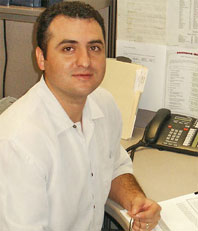 |
||||||
|
|
Number
316
|
February
2006
|
||||
|
P.O. Box 189, Moffett Field, CA 94035-0189 |
||||||
|
|
||||||
 |
||||||
|
|
Number
316
|
February
2006
|
||||
|
P.O. Box 189, Moffett Field, CA 94035-0189 |
||||||
|
|
||||||
|
“Heads Up” The Aviation Safety Reporting System receives approximately 3,000 reports each month. The subject matter of these reports runs the gamut from predictable “regulars,” such as runway incursions and altitude busts — to noteworthy new issues that may generate specific ASRS actions to help the industry resolve the issues. From time to time we note an increase of reports discussing these routine, but important tasks or actions; they often become quite visible when those performing them become less cautious in performing them and unexpected operational errors result. This issue of CALLBACK will provide a “Heads Up” regarding a few such recurring issues. Our hope is that reading about them will refresh your memory, and reduce the likelihood of an error. A second type of “Heads Up” we'll discuss in this issue will illuminate NEW, but potentialy critical issues that have come to our attention — often as a result of receiving large numbers of reports on a single issue in a short time period. Pilot/Controller Heads Up! — Altimeter Errors Every winter, areas of low pressure develop as storm systems move across the country. The low pressure areas and associated weather are predicted by meteorologists, tracked real-time by weather radar, and confirmed after the fact by increases in ASRS reports dealing with altitude overshoots, undershoots, and missed crossing restrictions. Winter weather will be around for a while yet. Heads up! Be alert for unusually low altimeter settings.
Flight Attendant Heads Up! — Cabin Doors Sometimes
there is no readily apparent reason for an influx of reports
dealing with a particular issue. It may simply be that enough
time has passed since there was widespread discussion or
increased emphasis on the matter and people have grown complacent.
Whatever the reason, there has been a recent surge in flight
attendant reports which deal with arming and disarming cabin
doors. Heads up! Check and cross-check.
Pilot/Controller Heads Up! — Similar Callsigns Errors resulting from similar sounding callsigns present another example of a chronic issue in which report volume may correspond to the amount of attention given to the problem. The following two reports, typical of several recent “callsign confusion” incidents, are an indication that pilots and controllers need to renew their awareness of this problem. Heads up! Listen up!
Pilot/Controller Heads Up! — DFW RNAV Departure To date, over sixty reports have been submitted to ASRS regarding deviations from the Dallas-Fort Worth (DFW) RNAV Standard Instrument Departures (SIDs). The following report highlights the problem most frequently cited, specifically, a track deviation from a transition portion of the SID.
ASRS examination of many reports similar to the above — occurring on DFW RNAV SIDs — has illuminated several recurring factors. The majority of the reported track deviations occurred on the TRANSITION portion of the RNAV SID procedure. Review of the reports indicates one of two things likely happened. Either the TRANSITION was never installed during FMC programming, or some ATC initiated modification, such as a departure runway change, resulted in the transition waypoints being eliminated. Pilots should be aware that three distinct departure elements must be line selected from the FMS Dep/Arr Page when programming the FMS for every RNAV SID from DFW. First, the assigned Runway must be line selected; second, the “Cleared” SID must be line selected and; third, the associated TRANSITION must be line selected. Note that every SID requires all three elements: Assigned Runway, the SID, and the appropriate TRANSITION. If, at any time, any ATC directed modification is made to any of these three essential elements, the FMS Legs page must be reviewed to ensure all waypoints have been retained or appropriately modified. Finally,
users of an ACARS PDC must be aware that the format for
the printed clearance may not display the transition in
the same manner it is shown on the departure plate, i.e.,
a clearance via the TRISS 2 departure TEXARKANA TRANSITION
may be printed: TRISS2 (space) TXK, not: TRISS2.(dot)TXK
as shown on the departure plate itself. This must not
be interpreted as direct to TXK after TRISS but, properly,
as a clearance to fly the TXK TRANSITION. Meet the Staff Jorge Moya  Jorge
Moya joined the ASRS staff as an Assistant Analyst
in 2000 while attending San Jose State University.
After graduating in 2002 with a B.S. in Aviation Operations
and minors in Business Management and Spanish, Jorge
became an ASRS Researcher and Alert Distribution Coordinator. Jorge
Moya joined the ASRS staff as an Assistant Analyst
in 2000 while attending San Jose State University.
After graduating in 2002 with a B.S. in Aviation Operations
and minors in Business Management and Spanish, Jorge
became an ASRS Researcher and Alert Distribution Coordinator.
Jorge conducts ASRS database searches for government and private entities, tabulates research data, and coordinates publication of related materials. Jorge is also a vital link in the timely dissemination of ASRS Safety Alert Bulletins. When he's not crunching data in the office, Jorge can be found tramping over the local golf links where he plays to a ten handicap. |
| ASRS Alerts Issued in January 2006 | |
|---|---|
|
Subject of Alert
|
No. of Alerts |
|
Aircraft
or aircraft equipment
|
7 |
|
Airport
facility or procedure
|
5 |
|
ATC
procedure or equipment
|
3 |
|
Chart
or publication
|
1 |
|
TOTAL
|
16 |
|
January 2006 Report Intake
|
|
|---|---|
| Air Carrier/Air Taxi Pilots |
2,209
|
| General Aviation Pilots |
661
|
| Controllers |
76
|
| Cabin/Mechanics/Military/Other |
268
|
| TOTAL |
3,214
|